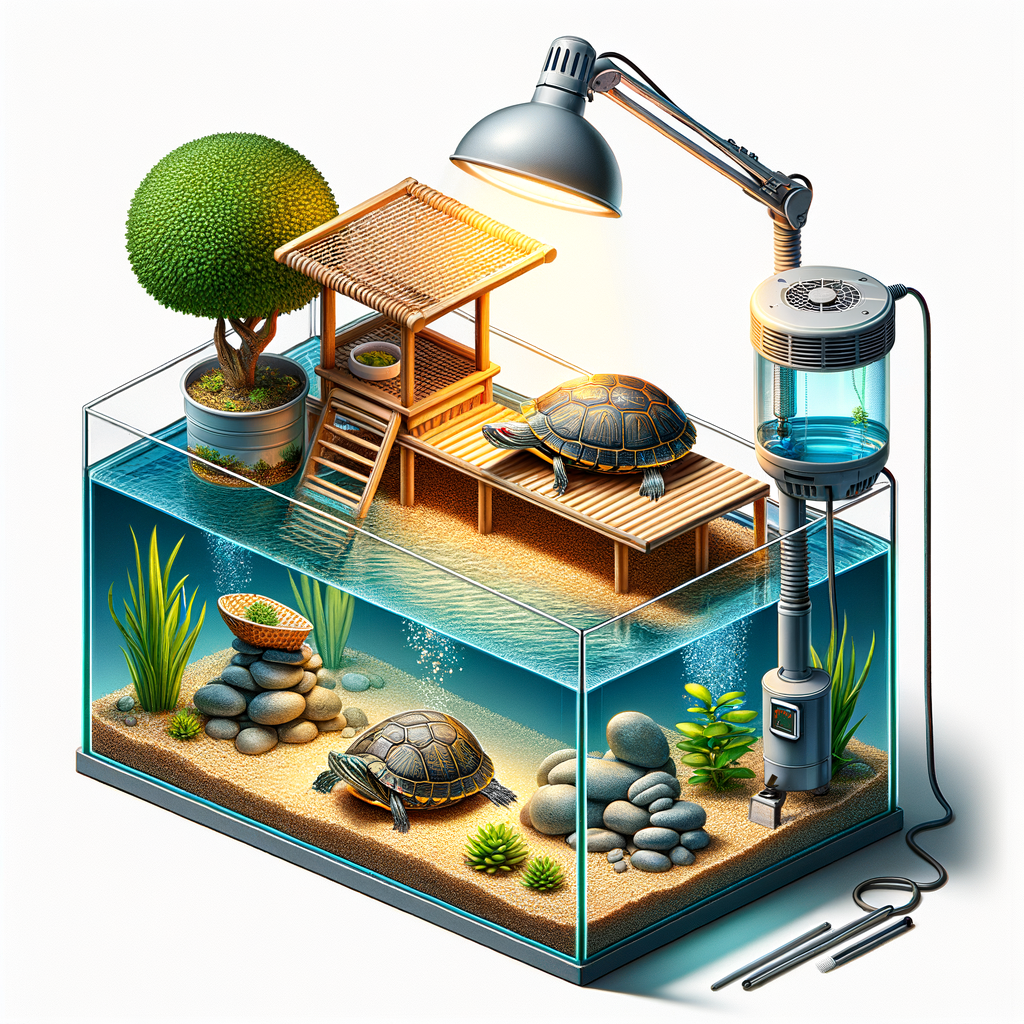
Introduction to Turtle Care Essentials for New Turtle Owners
Welcome to the world of turtle ownership! Turtles are fascinating creatures, each with their unique personality. However, they require specific care and attention to thrive. This guide will help you understand the commitment involved and the basic requirements for a healthy turtle.
- Understanding the Commitment
- Basic Requirements for a Healthy Turtle
- Proper Habitat: Turtles need a suitable living environment. This includes a tank with enough space to move around, a basking area, clean water, and proper lighting.
- Healthy Diet: Turtles need a balanced diet to stay healthy. This typically includes a mix of vegetables, fruits, and protein sources like insects or fish.
- Regular Exercise: Turtles need physical activity to stay healthy. This can include swimming for aquatic turtles or roaming around for terrestrial turtles.
- Veterinary Care: Regular check-ups with a vet who specializes in reptiles are essential to monitor your turtle’s health and catch any potential issues early.
Firstly, it’s important to understand that owning a turtle is a long-term commitment. Turtles have a long lifespan, with some species living up to 50 years or more. This means you’ll need to be prepared to care for your pet for many years to come.
Moreover, turtles require daily care, including feeding, cleaning their habitat, and monitoring their health. They also need social interaction and mental stimulation to stay happy and healthy. Therefore, owning a turtle is not a decision to be taken lightly.
There are several basic requirements to ensure your turtle stays healthy:
In the following sections, we’ll delve deeper into each of these areas, providing you with a comprehensive guide to turtle care. By understanding these essentials, you’ll be well-prepared to provide your new pet with a happy and healthy life.
Setting Up a Turtle Tank: Essential Turtle Tank Supplies
When setting up a turtle tank, it’s important to consider several factors to ensure your pet turtle’s comfort and health. One of the most crucial aspects is choosing the right tank. Let’s delve into the details.
Turtle Tank Equipment: Choosing the Right Tank
Choosing the right tank for your turtle can be a daunting task, especially if you’re a first-time turtle owner. However, by focusing on two key factors – size and capacity, and material and durability – you can make an informed decision.
- Size and Capacity Considerations
- Material and Durability
The size and capacity of your turtle tank are of utmost importance. Turtles need space to swim, bask, and hide. As a rule of thumb, for every inch of your turtle’s shell length, you should provide 10 gallons of water. For instance, if your turtle’s shell is 5 inches long, you’ll need a 50-gallon tank. This ensures your turtle has ample room to move around and live comfortably.
The material of your turtle tank also plays a significant role in its durability. Glass tanks are a popular choice due to their transparency and strength. They allow you to observe your turtle easily and are sturdy enough to hold the weight of the water. However, they can be heavy and difficult to move. Plastic tanks, on the other hand, are lighter and easier to handle, but they may not be as durable or clear as glass ones. Choose a material that best suits your needs and the needs of your pet turtle.
Remember, a happy turtle is a healthy turtle. By choosing the right tank, you’re setting the stage for your pet’s well-being and longevity.
Aquarium Equipment for Turtles: Filtration and Heating
When setting up a turtle tank, two key pieces of equipment you’ll need are a water filter and a heater. These are crucial to creating a healthy and comfortable environment for your pet turtle.
- Importance of Water Filtration
Water filtration is a must-have for any turtle tank. Turtles are messy creatures and produce a lot of waste. Without a good filter, the water in your turtle’s tank can quickly become dirty and unhealthy.
Dirty water can lead to a variety of health problems for your turtle, including skin and shell infections. It can also create a foul smell and make your turtle’s tank an unpleasant sight. A good water filter will help keep the water clean and clear, making your turtle happier and healthier.
| Benefits of Water Filtration |
|---|
| Keeps water clean and clear |
| Prevents health problems in turtles |
| Eliminates foul odors |
- Choosing the Right Water Heater
Turtles are cold-blooded animals, which means they can’t regulate their body temperature like humans can. They rely on their environment to stay warm. This is where a water heater comes in.
A water heater will keep the water in your turtle’s tank at a consistent temperature, which is crucial for your turtle’s health. If the water is too cold, your turtle can become sluggish and may even get sick. If it’s too hot, your turtle can become overheated and stressed.
When choosing a water heater, you’ll want to consider the size of your tank and the type of turtle you have. Different turtles have different temperature needs, so it’s important to do your research.
| Factors to Consider When Choosing a Water Heater |
|---|
| Size of your tank |
| Type of turtle |
| Temperature needs of your turtle |
In conclusion, both a water filter and a heater are essential pieces of equipment for a turtle tank. They help create a healthy and comfortable environment for your pet turtle, contributing to its overall well-being.
Turtle Habitat Setup: Creating a Comfortable Environment
Creating a comfortable environment for your turtle is crucial for its health and happiness. One of the key aspects of this is decorating your turtle tank. This involves choosing the right substrate and adding plants and decorations.
Decorating Your Turtle Tank
Decorating your turtle tank is not just about making it look good. It’s also about creating an environment that mimics your turtle’s natural habitat as closely as possible. This helps your turtle feel at home and promotes healthy behavior.
- Choosing the Right Substrate
- Adding Plants and Decorations
The substrate is the material that lines the bottom of your turtle tank. It’s important to choose a substrate that is safe for your turtle and easy to clean. Sand, pebbles, and aquarium gravel are popular choices. Avoid substrates with sharp edges that can harm your turtle, and avoid small particles that your turtle could accidentally swallow.
Plants and decorations add visual interest to your turtle tank and provide hiding places for your turtle. Choose plants that are safe for turtles, such as java ferns and anubias. Decorations can include rocks, driftwood, and turtle-safe toys. Remember to arrange your plants and decorations in a way that gives your turtle plenty of room to move around.
In conclusion, decorating your turtle tank involves careful selection of substrate and thoughtful placement of plants and decorations. By creating a comfortable and naturalistic environment, you can help ensure your turtle’s well-being.
Providing a Basking Area
One of the most important aspects of creating a comfortable environment for your turtle is providing a suitable basking area. This area is crucial for your turtle’s health and well-being. Let’s delve into the importance of a basking area and how to choose the right basking platform and lamp.
- Importance of a Basking Area
- Choosing the Right Basking Platform and Lamp
Just like humans need sunlight for vitamin D, turtles need a basking area to absorb heat and UV rays. This helps them digest their food, regulate their body temperature, and maintain their shell health. Without a proper basking area, turtles can suffer from health issues like metabolic bone disease and shell rot. Therefore, a basking area is not a luxury, but a necessity for your pet turtle.
When setting up a basking area, you need two main things: a basking platform and a basking lamp. The platform should be large enough for your turtle to comfortably fit on and easy for them to climb onto. It should also be sturdy and non-toxic.
The basking lamp should emit both UVA and UVB rays. UVA rays stimulate appetite, activity, and reproductive behavior, while UVB rays help turtles produce vitamin D3, which is essential for calcium absorption and shell health. The lamp’s wattage will depend on the size of your tank and the species of your turtle. As a general rule, the basking area should reach a temperature of 85-90 degrees Fahrenheit for most turtle species.
In conclusion, providing a proper basking area is a critical part of turtle care. By understanding its importance and knowing how to choose the right platform and lamp, you can create a comfortable and healthy environment for your pet turtle.
Turtle Tank Maintenance: Keeping Your Turtle’s Home Clean
Keeping your turtle’s tank clean is crucial for their health and happiness. A clean tank not only makes your pet turtle’s home look good, but it also prevents the build-up of harmful bacteria and algae. Here are some key steps to maintaining a clean turtle tank.
- Regular Cleaning Schedule
- Replacing the Water
- Cleaning the Tank and Accessories
Establishing a regular cleaning schedule is the first step towards maintaining a clean turtle tank. It’s recommended to do a partial water change and spot clean the tank once a week. This involves removing about 25% of the tank’s water and replacing it with fresh, dechlorinated water. Spot cleaning means removing any visible waste or uneaten food from the tank. A full tank clean, which involves completely emptying the tank and cleaning all surfaces and accessories, should be done once a month.
Replacing the water in your turtle’s tank is a vital part of the cleaning process. Turtles produce a lot of waste, which can quickly dirty the water. When replacing the water, make sure to use dechlorinated water as chlorine can be harmful to turtles. A water conditioner can be used to remove chlorine from tap water. It’s also important to maintain the right water temperature when adding new water to the tank. The water temperature should be between 75 and 85 degrees Fahrenheit.
Cleaning the tank and its accessories is an essential part of turtle tank maintenance. This includes cleaning the tank walls, substrate, and any decorations or hiding spots in the tank. Use a scrub brush to remove any algae from the tank walls. The substrate should be rinsed thoroughly to remove any waste or leftover food. Accessories should be cleaned with warm water and a mild soap, then rinsed thoroughly to remove any soap residue.
In conclusion, maintaining a clean turtle tank requires a regular cleaning schedule, replacing the water regularly, and cleaning the tank and its accessories. By following these steps, you can ensure that your turtle has a clean and healthy environment to live in.
Must-Have Turtle Supplies: Feeding and Health Care
Feeding your turtle correctly and ensuring they receive the right health care is essential for their well-being. Let’s delve into the specifics.
Feeding Your Turtle: Diet Essentials
Understanding your turtle’s dietary needs and choosing the right food are key steps in ensuring your pet’s health and happiness. Let’s explore these steps in detail.
- Understanding your turtle’s dietary needs
- Choosing the right turtle food
Each turtle species has unique dietary needs. For instance, some turtles are herbivores, others are carnivores, and some are omnivores. It’s crucial to research your specific turtle species to understand their dietary needs. For example, a Green Sea Turtle is primarily herbivorous, feeding on seagrasses and algae. In contrast, a Loggerhead Turtle is carnivorous, feeding on jellyfish, conchs, crabs, and even fish.
Once you understand your turtle’s dietary needs, the next step is to choose the right food. Commercial turtle food often comes in pellets, sticks, or canned forms. These foods are formulated to provide a balanced diet for your turtle. However, it’s also important to supplement this with fresh food. For herbivorous turtles, this could include leafy greens, vegetables, and fruits. For carnivorous turtles, this could mean small fish, insects, or even cooked chicken. Remember, variety is key to a balanced diet.
In conclusion, understanding your turtle’s dietary needs and choosing the right food are essential steps in turtle care. By providing a balanced and varied diet, you can ensure your turtle’s health and longevity.
Health Care for Your Turtle
Just like any other pet, turtles require regular health care to ensure they live a long, happy, and healthy life. This includes regular health checks and being aware of common health issues that can affect turtles. Let’s delve into these two critical aspects of turtle health care.
-
Regular Health Checks
Regular health checks are essential for your turtle’s well-being. These checks help you detect any potential health issues early, making them easier to treat. It’s recommended to have a vet who specializes in reptiles perform a health check on your turtle at least once a year. During these checks, the vet will examine your turtle’s shell, eyes, mouth, and overall body condition. They may also perform tests to check for parasites or other health issues.
-
Common Health Issues and How to Spot Them
Turtles can suffer from a variety of health issues. Some of the most common include respiratory infections, shell rot, and vitamin A deficiency. Here’s how you can spot them:
Health Issue Symptoms Respiratory Infections Difficulty breathing, loss of appetite, lethargy, and nasal discharge. Shell Rot Soft spots on the shell, foul smell, and visible pus or blood. Vitamin A Deficiency Swollen eyes, lack of appetite, and changes in skin color. If you notice any of these symptoms, it’s crucial to seek veterinary care immediately. Early detection and treatment can significantly improve your turtle’s chances of recovery.
Remember, a healthy turtle is a happy turtle. By providing regular health checks and being aware of common health issues, you can ensure your pet turtle lives a long, healthy life.
Pet Turtle Care Guide: Ensuring a Happy and Healthy Turtle
Keeping your pet turtle happy and healthy is not just about providing the right environment and diet. It also involves understanding their behavior, providing mental stimulation, and knowing how to handle and interact with them properly. Let’s delve into these aspects.
- Understanding your turtle’s behavior
- Providing mental stimulation
- Handling and interacting with your turtle
Turtles exhibit a variety of behaviors that can tell you a lot about their health and happiness. For instance, basking in the sun is a common behavior that helps them regulate their body temperature. If your turtle is not basking as much as it usually does, it could be a sign of illness. Similarly, if your turtle is eating less or not at all, it could be a sign of stress or disease. It’s important to monitor your turtle’s behavior closely and consult a vet if you notice any changes.
Turtles are intelligent creatures that need mental stimulation to stay happy. This can be provided by adding items to their tank that they can explore and interact with, such as rocks, plants, and hiding spots. You can also change the layout of their tank every few months to give them a new environment to explore. Providing toys that they can push or manipulate can also help keep them mentally stimulated.
While turtles are not typically as interactive as other pets, they do enjoy some level of interaction. Handling your turtle gently and regularly can help them get used to human contact and reduce stress. However, it’s important to wash your hands before and after handling your turtle to prevent the spread of diseases. Also, remember that turtles are not toys and should be handled with respect and care.
In conclusion, understanding your turtle’s behavior, providing mental stimulation, and handling them properly are key to ensuring their happiness and health. Remember, a happy turtle is a healthy turtle!
Conclusion: Enjoying Your New Pet Turtle
As we come to the end of our guide, let’s take a moment to recap the essential points we’ve covered. Owning a pet turtle can be a rewarding experience, but it also requires a lot of care and attention. Let’s go over the key points one more time.
- Introduction to Turtle Care: Owning a turtle is a long-term commitment. They require a specific environment, diet, and care to thrive.
- Setting Up a Turtle Tank: Your turtle’s tank should be spacious, clean, and equipped with the necessary supplies like a heat lamp, UVB light, and filter.
- Turtle Habitat Setup: Creating a comfortable environment for your turtle involves setting up a basking area, providing clean water, and maintaining the right temperature and humidity levels.
- Turtle Tank Maintenance: Regular cleaning of the tank and filter is crucial to prevent the growth of harmful bacteria and keep your turtle healthy.
- Must-Have Turtle Supplies: Apart from the tank setup, your turtle will need a balanced diet and regular health checks.
- Pet Turtle Care Guide: Ensuring a happy and healthy turtle involves monitoring their behavior, health, and diet regularly.
To all the new turtle owners out there, we want to encourage you. It might seem overwhelming at first, but with time, patience, and the right knowledge, you can provide a happy and healthy life for your pet turtle. Remember, every effort you put into your turtle’s care will be rewarded with their long life and unique companionship.
So, take a deep breath, and embark on this exciting journey of pet turtle ownership. You’ve got this!














